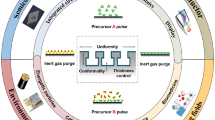Abstract
A novel hot embossing method is developed to fabricate polymer nanochannels. The pattern on the silicon nanomould is transferred to polymethylmethacrylate (PMMA) plates, and then polyethylene terephthalate (PET) nanochannels are embossed by using the PMMA mould. The use of the PMMA intermediate mould can extremely increase the device yield of the expensive silicon nanomould. To avoid the use of nanolithography, a method based on UV-lithography techniques for fabricating silicon nanomoulds with sub-micrometer width was put forward. 1 PMMA mould can be used to repeatedly emboss at least 30 PET substrates without damage and obvious deformation. Good pattern fidelity of PET nanochannels was obtained at the optimized embossing temperature of 90 °C. For an 808 nm-wide and 195 nm-deep nanochannel, the variations in width and depth between PET nanochannels and PMMA moulds were 1.8 and 2.5 %, respectively. The reproducibility was also evaluated, and the relative standard deviations in width and depth of 5 PET nanochannels were 5.1 and 7.3 %, respectively.





Similar content being viewed by others
References
Abgrall P, Low LN, Nguyen NT (2007) Fabrication of planar nanofluidic channels in a thermoplastic by hot-embossing and thermal bonding. Lab Chip 7:520–522. doi:10.1039/b616134k
Deal BE, Grove AS (1965) General relationship for the thermal oxidation of silicon. J Appl Phys 36:3770–3778. doi:10.1063/1.1713945
Eijkel JCT, Bomer J, Tas NR, van den Berg A (2004) 1-D nanochannels fabricated in polyimide. Lab Chip 4:161–163. doi:10.1039/b315859d
Fanzio P, Mussi V, Manneschi C, Angeli E, Firpo G, Repetto L, Valbusa U (2011) DNA detection with a polymeric nanochannel device. Lab Chip 11:2961–2966. doi:10.1039/c1lc20243j
Hoang HT, Segers-Nolten IM, Berenschot JW, de Boer MJ, Tas NR, Haneveld J, Elwenspoek MC (2009) Fabrication and interfacing of nanochannel devices for single-molecule studies. J Micromech Microeng 19:065017. doi:10.1088/0960-1317/19/6/065017
Liang XG, Morton KJ, Austin RH, Chou SY (2007) Single sub-20 nm wide, centimeter-long nanofluidic channel fabricated by novel nanoimprint mould fabrication and direct imprinting. Nano Lett 7:3774–3780. doi:10.1021/nl072253x
Liu JS, Liu C, Guo JH, Wang LD (2006) Electrostatic bonding of a silicon master to a glass wafer for plastic microchannel fabrication. J Mater Process Technol 178:278–282. doi:10.1016/j.jmatprotec.2006.04.009
Liu JS, Qiao HC, Xu Z, Liu C, Wang JY, Du LQ, Zhang X, Wang LD (2012) Fabrication of planar nanofluidic channels in thermoplastic polymers by O2 plasma etching. Micro Nano Lett 7:159–162. doi:10.1049/mnl.2011.0651
Mokkapati VRSS, Di Virgilio V, Shen C, Mollinger J, Bastemeijer J, Bossche A (2011) DNA tracking within a nanochannel: device fabrication and experiments. Lab Chip 11:2711–2719. doi:10.1039/c1lc20075e
Shao PG, van Kan A, Wang LP, Ansari K, Bettiol AA, Watt F (2006) Fabrication of enclosed nanochannels in poly(methylmethacrylate) using proton beam writing and thermal bonding. Appl Phys Lett 88:093515. doi:10.1063/1.2181631
Sivanesan P, Okamoto K, English D, Lee CS, DeVoe DL (2005) Polymer nanochannels fabricated by thermomechanical deformation for single-molecule analysis. Anal Chem 77:2252–2258. doi:10.1021/ac048923q
Studer V, Pepin A, Chen Y (2002) Nanoembossing of thermoplastic polymers for microfluidic applications. Appl Phys Lett 80:3614–3616. doi:10.1063/1.1479202
Utko P, Persson F, Kristensen A, Larsen NB (2011) Injection moulded nanofluidic chips: fabrication method and functional tests using single-molecule DNA experiments. Lab Chip 11:303–308. doi:10.1039/c0lc00260g
Wang C, Li SJ, Wu ZQ, Xu JJ, Chen HY, Xia XH (2010) Study on the kinetics of homogeneous enzyme reactions in a micro/nanofluidics device. Lab Chip 10:639–646. doi:10.1039/b915762j
Wang JY, Xu Z, Liu C, Liu JS, Liu YL, Wang LD, Yang WD (2012) Effects of electrophoresis and electroosmotic flow on ion enrichment in micro-nanofluidic preconcentrator. Microsyst Technol 18:97–102. doi:10.1007/s00542-011-1386-8
Wu JH, Chantiwas R, Amirsadeghi A, Soper SA, Park S (2011) Complete plastic nanofluidic devices for DNA analysis via direct imprinting with polymer stamps. Lab Chip 11:2984–2989. doi:10.1039/c1lc20294d
Xu JD, Locascio L, Gaitan M, Lee CS (2000) Room-temperature imprinting method for plastic microchannel fabrication. Anal Chem 72:1930–1933. doi:10.1021/ac991216q
Yoon TH, Hong LY, Lee CS, Kim DP (2008) Fabrication of hybrid-nanofluidic with hydrophilic polymer for DNA separation capillary electrophoresis module. J Phys Chem Solids 69:1325–1329. doi:10.1016/j.jpcs.2007.10.135
Yu H, Lu Y, Zhou YG, Wang FB, He FY, Xia XH (2008) A simple, disposable microfluidic device for rapid protein concentration and purification via direct-printing. Lab Chip 8:1496–1501. doi:10.1039/b802778a
Zhang ZB, Luo Y, Wang XD, He SQ, Meng FT, Wang LD (2010) Bonding of planar poly (methyl methacrylate) (PMMA) nanofluidic channels using thermal assisted ultrasonic bonding method. Microsyst Technol 16:2043–2048. doi:10.1007/s00542-010-1140-7
Acknowledgments
This work was supported by the National Natural Science Foundation of China (51075056), (91023046), the National High-tech R&D Program of China (2012AA040406), and the Program for New Century Excellent Talents in University of China (NCET-10-0284).
Author information
Authors and Affiliations
Corresponding author
Rights and permissions
About this article
Cite this article
Liu, J., Jin, X., Sun, T. et al. Hot embossing of polymer nanochannels using PMMA moulds. Microsyst Technol 19, 629–634 (2013). https://doi.org/10.1007/s00542-012-1674-y
Received:
Accepted:
Published:
Issue Date:
DOI: https://doi.org/10.1007/s00542-012-1674-y




